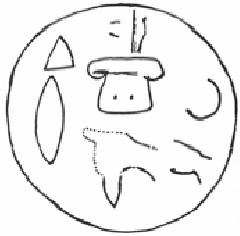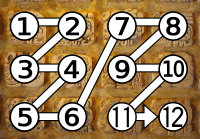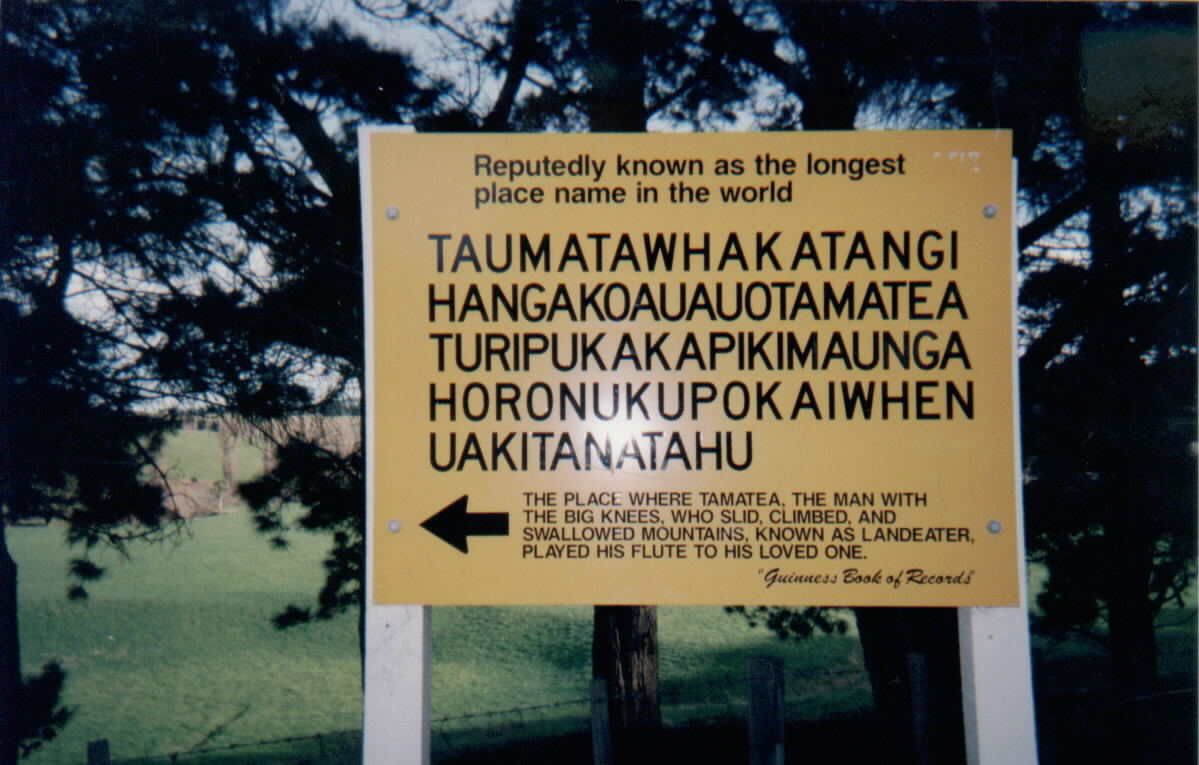|
Logographic
In a written language, a logogram (from Ancient Greek 'word', and 'that which is drawn or written'), also logograph or lexigraph, is a written character that represents a semantic component of a language, such as a word or morpheme. Chinese characters as used in Written Chinese, Chinese as well as other languages are logograms, as are Egyptian hieroglyphs and characters in cuneiform script. A writing system that primarily uses logograms is called a ''logography''. Non-logographic writing systems, such as alphabets and syllabaries, are ''phonemic'': their individual symbols represent sounds directly and lack any inherent meaning. However, all known logographies have some phonetic component, generally based on the rebus principle, and the addition of a phonetic component to pure ideographs is considered to be a key innovation in enabling the writing system to adequately encode human language. Types of logographic systems Some of the earliest recorded writing systems are logograp ... [...More Info...] [...Related Items...] OR: [Wikipedia] [Google] [Baidu] [Amazon] |
Cuneiform Script
Cuneiform is a Logogram, logo-Syllabary, syllabic writing system that was used to write several languages of the Ancient Near East. The script was in active use from the early Bronze Age until the beginning of the Common Era. Cuneiform scripts are marked by and named for the characteristic wedge-shaped impressions (Latin: ) which form their Grapheme, signs. Cuneiform is the History of writing#Inventions of writing, earliest known writing system and was originally developed to write the Sumerian language of southern Mesopotamia (modern Iraq). Over the course of its history, cuneiform was adapted to write a number of languages in addition to Sumerian. Akkadian language, Akkadian texts are attested from the 24th century BC onward and make up the bulk of the cuneiform record. Akkadian cuneiform was itself adapted to write the Hittite language in the early second millennium BC. The other languages with significant cuneiform Text corpus, corpora are Eblaite language, Eblaite, Elamit ... [...More Info...] [...Related Items...] OR: [Wikipedia] [Google] [Baidu] [Amazon] |
Anatolian Hieroglyphs
Anatolian hieroglyphs are an indigenous logographic script native to central Anatolia, consisting of some 500 signs. They were once commonly known as Hittite hieroglyphs, but the language they encode proved to be Luwian language, Luwian, not Hittite language, Hittite, and the term Luwian hieroglyphs is used in English publications. They are typologically similar to Egyptian hieroglyphs, but do not derive graphically from that script, and they are not known to have played the sacred role of hieroglyphs in Egypt. There is no demonstrable connection to Hittite cuneiform. History Individual Anatolian hieroglyphs are attested from the second and early first millennia BC across Anatolia and into modern Syria. A biconvex bronze personal seal was found in the Late Bronze Age Troy, Troy VIIb level (later half of the 12th century BC) inscribed with Luwian Hieroglyphs. The earliest examples occur on personal Seal (emblem), seals, but these consist only of names, titles, and auspicious sign ... [...More Info...] [...Related Items...] OR: [Wikipedia] [Google] [Baidu] [Amazon] |
Writing System
A writing system comprises a set of symbols, called a ''script'', as well as the rules by which the script represents a particular language. The earliest writing appeared during the late 4th millennium BC. Throughout history, each independently invented writing system gradually emerged from a system of proto-writing, where a small number of ideographs were used in a manner incapable of fully encoding language, and thus lacking the ability to express a broad range of ideas. Writing systems are generally classified according to how its symbols, called ''graphemes'', relate to units of language. Phonetic writing systemswhich include alphabets and syllabariesuse graphemes that correspond to sounds in the corresponding spoken language. Alphabets use graphemes called ''letter (alphabet), letters'' that generally correspond to spoken phonemes. They are typically divided into three sub-types: ''Pure alphabets'' use letters to represent both consonant and vowel sounds, ''abjads'' gene ... [...More Info...] [...Related Items...] OR: [Wikipedia] [Google] [Baidu] [Amazon] |
Mixtec Writing
Mixtec writing originated as a logographic writing system during the Post-Classic period in Mesoamerican history. Records of genealogy, historic events, and cultural narratives are found in the pre-Columbian Mixtec codices. The arrival of Europeans in 1520 AD caused changes in form, style, and the function of the Mixtec writings. Today these codices and other Mixtec writings are used as a source of ethnographic, linguistic, and historical information for scholars, and help to preserve the identity of the Mixtec people as migration and globalization introduce new cultural influences. Mixtec history The Mixtec are an indigenous people of Mesoamerica, located in the western region of the modern Mexican states of Oaxaca, eastern part of Guerrero, and southern part of Puebla. The history of the Mixtec people can be traced back to the Formative period, and continues through the Classic and Post-Classic periods to the arrival of Europeans in 1520 AD. Today the region is still populat ... [...More Info...] [...Related Items...] OR: [Wikipedia] [Google] [Baidu] [Amazon] |
Maya Script
Maya script, also known as Maya glyphs, is historically the native writing system of the Maya civilization of Mesoamerica and is the only Mesoamerican writing system that has been substantially deciphered. The earliest inscriptions found which are identifiably Maya date to the 3rd century BCE in San Bartolo, Guatemala. Maya writing was in continuous use throughout Mesoamerica until the Spanish conquest of the Maya in the 16th and 17th centuries. Though modern Mayan languages are almost entirely written using the Latin alphabet rather than Maya script, there have been recent developments encouraging a revival of the Maya glyph system. Maya writing used logograms complemented with a set of syllabic glyphs, somewhat similar in function to modern Japanese writing. Maya writing was called "hieroglyphics" or hieroglyphs by early European explorers of the 18th and 19th centuries who found its general appearance reminiscent of Egyptian hieroglyphs, although the two systems are unre ... [...More Info...] [...Related Items...] OR: [Wikipedia] [Google] [Baidu] [Amazon] |
Word
A word is a basic element of language that carries semantics, meaning, can be used on its own, and is uninterruptible. Despite the fact that language speakers often have an intuitive grasp of what a word is, there is no consensus among linguistics, linguists on its definition and numerous attempts to find specific criteria of the concept remain controversial. Different standards have been proposed, depending on the theoretical background and descriptive context; these do not converge on a single definition. Some specific definitions of the term "word" are employed to convey its different meanings at different levels of description, for example based on phonology, phonological, grammar, grammatical or orthography, orthographic basis. Others suggest that the concept is simply a convention used in everyday situations. The concept of "word" is distinguished from that of a morpheme, which is the smallest unit of language that has a meaning, even if it cannot stand on its own. Words a ... [...More Info...] [...Related Items...] OR: [Wikipedia] [Google] [Baidu] [Amazon] |
Determinative
A determinative, also known as a taxogram or semagram, is an ideogram used to mark semantic categories of words in logographic scripts which helps to disambiguate interpretation. They have no direct counterpart in spoken language, though they may derive historically from glyphs for real words, and functionally they resemble classifiers in East Asian and sign languages. For example, Egyptian hieroglyphic determinatives include symbols for divinities, people, parts of the body, animals, plants, and books/abstract ideas, which helped in reading but were not pronounced. Cuneiform In cuneiform texts of Sumerian, Akkadian and Hittite languages, many nouns are preceded or followed by a Sumerian word acting as a determinative; this specifies that the associated word belongs to a particular semantic group.Edzard, 2003 These determinatives were not pronounced. In transliterations of Sumerian, the determinatives are written in superscript in upper case. Whether a given sign is a m ... [...More Info...] [...Related Items...] OR: [Wikipedia] [Google] [Baidu] [Amazon] |
Hieroglyph
Ancient Egyptian hieroglyphs ( ) were the formal writing system used in Ancient Egypt for writing the Egyptian language. Hieroglyphs combined ideographic, logographic, syllabic and alphabetic elements, with more than 1,000 distinct characters.In total, there were about 1,000 graphemes in use during the Old Kingdom period; this number decreased to 750–850 during the Middle Kingdom, but rose instead to around 5,000 signs during the Ptolemaic period. Antonio Loprieno, ''Ancient Egyptian: A Linguistic Introduction'' (Cambridge: Cambridge UP, 1995), p. 12. Cursive hieroglyphs were used for religious literature on papyrus and wood. The later hieratic and demotic Egyptian scripts were derived from hieroglyphic writing, as was the Proto-Sinaitic script that later evolved into the Phoenician alphabet. Egyptian hieroglyphs are the ultimate ancestor of the Phoenician alphabet, the first widely adopted phonetic writing system. Moreover, owing in large part to the Greek and Aramaic sc ... [...More Info...] [...Related Items...] OR: [Wikipedia] [Google] [Baidu] [Amazon] |
Written Language
A written language is the representation of a language by means of writing. This involves the use of visual symbols, known as graphemes, to represent linguistic units such as phonemes, syllables, morphemes, or words. However, written language is not merely spoken or signed language written down, though it can approximate that. Instead, it is a separate system with its own norms, structures, and stylistic conventions, and it often evolves differently than its corresponding spoken or signed language. Written languages serve as crucial tools for communication, enabling the recording, preservation, and transmission of information, ideas, and culture across time and space. The orthography of a written language comprises the norms by which it is expected to function, including rules regarding spelling and typography. A society's use of written language generally has a profound impact on its social organization, cultural identity, and technological profile. Relationship with spoken a ... [...More Info...] [...Related Items...] OR: [Wikipedia] [Google] [Baidu] [Amazon] |
Ideographs
An ideogram or ideograph (from Ancient Greek, Greek 'idea' + 'to write') is a symbol that is used within a given writing system to represent an idea or concept in a given language. (Ideograms are contrasted with phonogram (linguistics), phonograms, which indicate sounds of speech and thus are independent of any particular language.) Some ideograms are more arbitrary than others: some are only meaningful assuming preexisting familiarity with some convention; others more directly resemble their signifieds. Ideograms that represent physical objects by visually illustrating them are called ''pictograms''. * Numeral system, Numerals and List of mathematical symbols, mathematical symbols are ideograms, for example ⟨1⟩ 'one', ⟨2⟩ 'two', ⟨+⟩ 'plus', and ⟨=⟩ 'equals'. * The ampersand ⟨&⟩ is used in many languages to represent the word ''and'', originally a stylized Ligature (writing), ligature of the Latin word . * Other typographical examples include ⟨§⟩ 'sect ... [...More Info...] [...Related Items...] OR: [Wikipedia] [Google] [Baidu] [Amazon] |
Graphemes
In linguistics, a grapheme is the smallest functional unit of a writing system. The word ''grapheme'' is derived from Ancient Greek ('write'), and the suffix ''-eme'' by analogy with ''phoneme'' and other emic units. The study of graphemes is called '' graphemics''. The concept of graphemes is abstract and similar to the notion in computing of a character. (A specific geometric shape that represents any particular grapheme in a given typeface is called a glyph.) Conceptualization There are two main opposing grapheme concepts. In the so-called ''referential conception'', graphemes are interpreted as the smallest units of writing that correspond with sounds (more accurately phonemes). In this concept, the ''sh'' in the written English word ''shake'' would be a grapheme because it represents the phoneme /ʃ/. This referential concept is linked to the ''dependency hypothesis'' that claims that writing merely depicts speech. By contrast, the ''analogical concept'' defines gr ... [...More Info...] [...Related Items...] OR: [Wikipedia] [Google] [Baidu] [Amazon] |
Alphabet
An alphabet is a standard set of letter (alphabet), letters written to represent particular sounds in a spoken language. Specifically, letters largely correspond to phonemes as the smallest sound segments that can distinguish one word from another in a given language. Not all writing systems represent language in this way: a syllabary assigns symbols to spoken syllables, while logographies assign symbols to words, morphemes, or other semantic units. The first letters were invented in Ancient Egypt to serve as an aid in writing Egyptian hieroglyphs; these are referred to as Egyptian uniliteral signs by lexicographers. This system was used until the 5th century AD, and fundamentally differed by adding pronunciation hints to existing hieroglyphs that had previously carried no pronunciation information. Later on, these phonemic symbols also became used to transcribe foreign words. The first fully phonemic script was the Proto-Sinaitic script, also descending from Egyptian hi ... [...More Info...] [...Related Items...] OR: [Wikipedia] [Google] [Baidu] [Amazon] |






